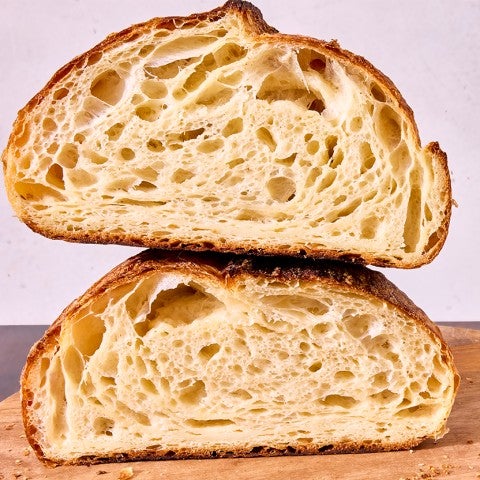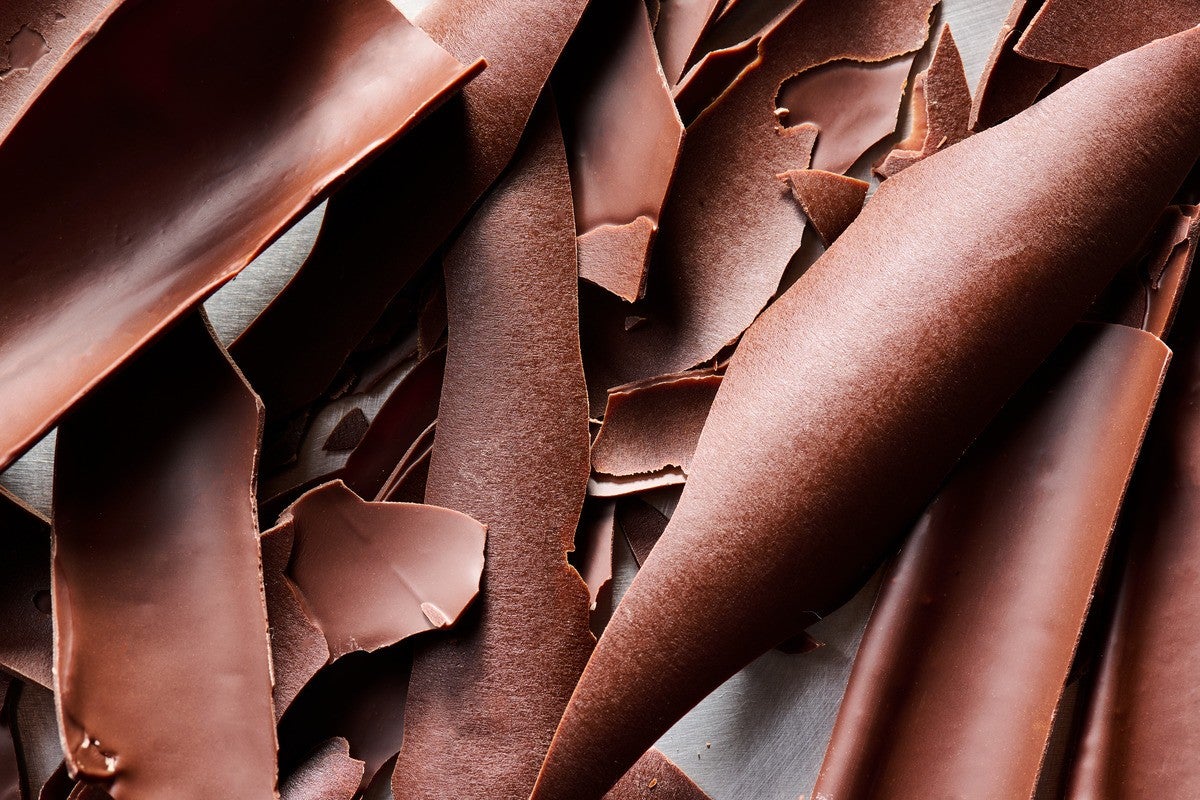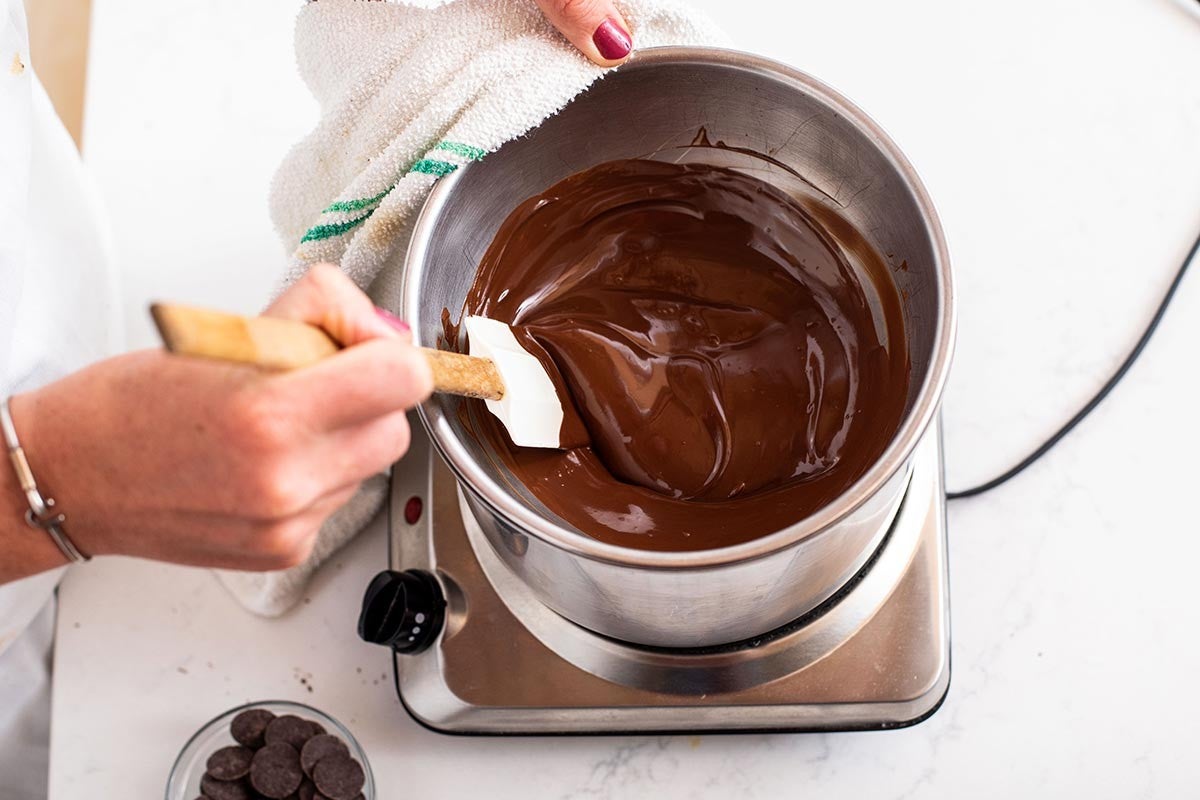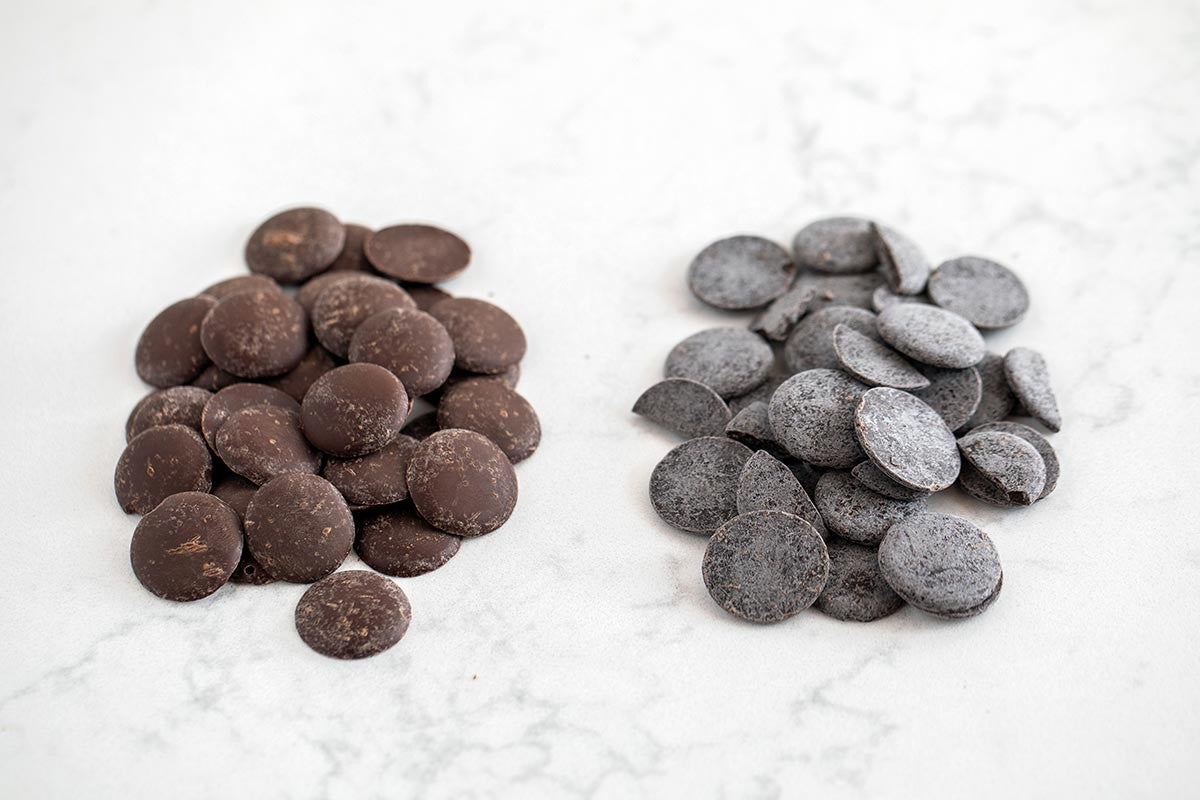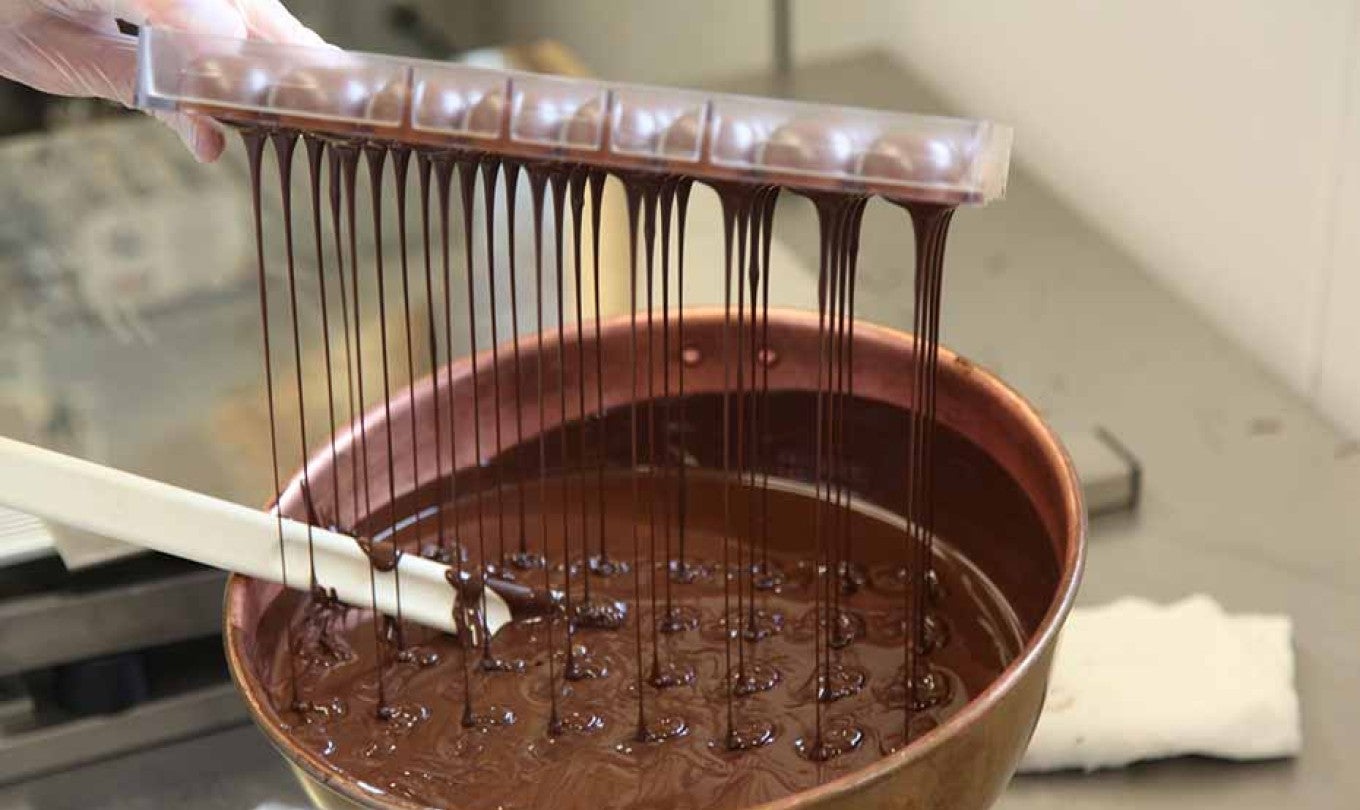
How to Temper Chocolate
Tips and techniques to temper chocolateIn this guide:
- What is tempered chocolate?
- How the tempering process works
- How long does tempered chocolate take to harden?
- Chocolate tempering temperatures
- Our preferred tempering method: The seeding method
- How to temper chocolate using the seeding method
- How to temper chocolate with alternative methods
- How to test chocolate for temper
- Chocolate terms to know
What is tempered chocolate?
Tempered chocolate has been melted, cooled, and handled in a manner that allows very specific fat crystals (called beta crystals) to form. The result is chocolate that’s shiny, will snap when broken, and isn’t tacky to the touch. Unless it’s been abused in shipping (usually, allowed to get too hot somewhere along the way), virtually all chocolate you buy is in temper.
It is possible, with great care and attention, to very gently melt tempered chocolate to precisely 90°F, and therefore keep it in temper as it’s melted. It’s difficult to do, though, and most people working with chocolate melt and re-temper it.
How the tempering process works
Regardless of what path one takes to temper chocolate, here’s what happens. First, chocolate must be melted to a temperature that will melt all the different types of fat crystals present.
Next, the chocolate is cooled while being stirred, often with the addition of more chocolate that’s already in temper, to help a uniform structure of crystals to reform. Once the mixture is at the right temperature, the chocolate is used to line molds, coat centers, or dip cookies in, and set out at cool room temperature.
How long does tempered chocolate take to harden?
If the chocolate is properly in temper, it will set within 3 to 5 minutes.
Chocolate tempering temperatures
| Chocolate type | 1st melt | Seed | Cool | Maintain at temp (stirring frequently) |
|---|---|---|---|---|
| Dark chocolate | 122°F (50°C) | Seed with 25% of melted volume or weight | Cool to 90°F (32°C) | 86° to 90°F (30° to 32°C) |
| Milk or white chocolate | 105° F (40°C) | Seed with 25% of melted volume or weight | Cool to 90°F (32°C) | 84° to 86°F (28.9°to 30°C) |
You can do all of the steps above with a simmering water bath, a bowl, a thermometer, rubber spatula (to stir with) and a knife (to chop the chocolate).
Our preferred tempering method: The seeding method
In this method, chocolate is melted, then more chocolate is chopped and added to “seed” the melted chocolate. The stable crystals in the chopped chocolate encourage the formation of stable beta crystals in the melted chocolate. Stirring is very important, to keep the smallest beta crystals possible in suspension.
At that point, the chocolate must be cooled to 88° to 90°F (27°C) while being stirred continuously. If your bowl of chocolate contains any chunks at that temperature, gently warm it to melt the remaining chunks. You can do this over warm water, or even with a hair dryer. If the chocolate is too warm, you can add some more chunks, a few at a time, while stirring to cool to the correct working temperature.
After cooling, the chocolate is kept at its working temperature for dipping, pouring, spreading, or piping.
How to temper chocolate using the seeding method
You'll need: 454g (1 pound) of semisweet chocolate, preferably 60% to 65% cocoa content. For best results, use chocolate wafers or chopped chocolate from a bar; chocolate chips will also work here.
- Bring a double boiler filled with 1" of water to a simmer. Place 340g (2 cups) of the chocolate into the bowl of the double boiler and turn off the heat (keep it over the saucepan of hot water). Allow the chocolate to melt, stirring constantly. The chocolate should stay below 122°F to ensure proper tempering.
- Once melted, remove the bowl from the double boiler and place it on your work surface. Stir in the remaining 114g (2/3 cup) chocolate (your “seed chocolate”), adding about one-third of the chocolate at a time, testing the temperature occasionally: Once the mixture has cooled to 80°F to 82°F, return the bowl of chocolate to the turned-off double boiler and reheat gently until the temperature reaches 88°F to 90°F. At this point, the chocolate is tempered and ready to work with.
- Use your tempered chocolate as desired, being sure to work quickly and reheat as needed: spread it evenly on a parchment-lined baking sheet to make chocolate shards, use it to coat truffles or dried fruit, or make homemade candy bars or chocolate bark.
- Allow the chocolate to set at room temperature for 3 to 5 minutes for thinner coatings (like dipped fruit) or 5 to 10 minutes for thicker layers of chocolate (like bark).
Baker's tips:
- During the tempering process, you may not end up adding all of the remaining “seed chocolate.” Refrain from adding more to the melted chocolate once it reaches 80°F to 82°F.
- If at any point the melted chocolate becomes too cool and starts to harden, place it over the turned-off double-boiler and reheat gently, making sure the temperature of the chocolate doesn’t exceed 90°F.
How to temper chocolate with alternative methods
Block seeding
In this method, a large chunk of tempered chocolate is added to warm, melted chocolate and stirred until the melted chocolate is cooled to temper. Once the melted chocolate is brought to temper, the block is removed and can be reused. This method is simple but slightly more time consuming. It has the advantage of having an easily discernible chunk of chocolate that you can remove from your working, melted chocolate.
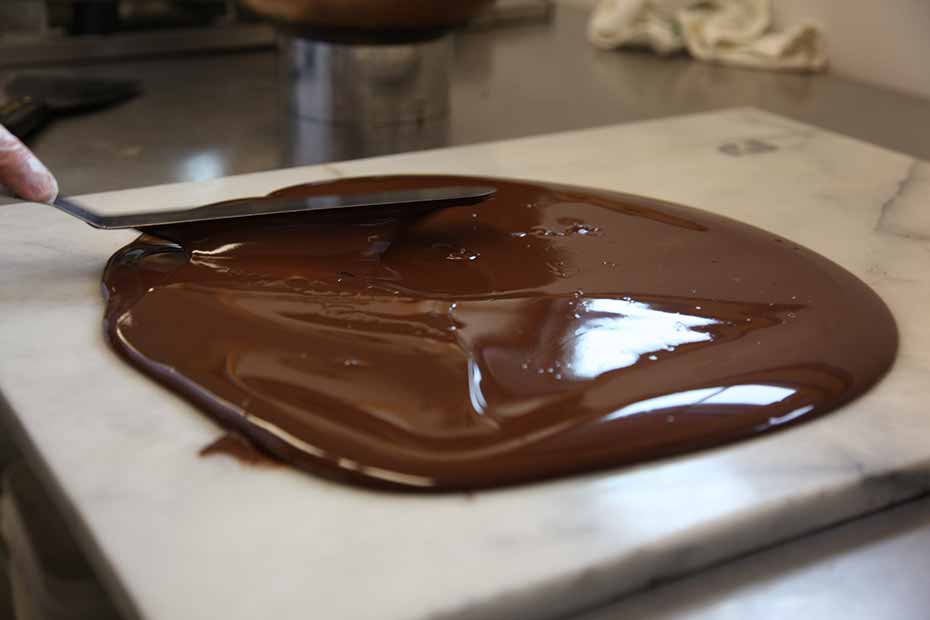
Tabling
This method is used for relatively small amounts of chocolate; confectioners like it because it’s fast and efficient. To temper chocolate by tabling, melt the chocolate to 122°F/50°C for dark and 105°F/40°C for milk or white to remove all existing cocoa butter crystals. Pour 1/2 to 2/3 of the melted chocolate onto a scrupulously clean and absolutely dry marble slab. It’s then spread back and forth with a metal spatula until it begins to thicken. As this happens, it begins to take on a paste-like consistency and dull color as the beta crystals begin to form. This mass is then added back to the remaining melted chocolate to seed and cool it, stirring constantly. After the chocolate is brought to temper, it’s maintained at working temperature (remember to stir frequently): 86° to 90°F/30° to 32°C.
Incomplete melting
You can use a microwave to warm water bath melt about 80% of a volume of chopped tempered chocolate. This method relies on using the remaining unmelted chocolate as the seed. It’s important to make sure the melted portion of the chocolate doesn’t bet above 97°F/36°C. Microwaves can create hot spots in chocolate, so it’s best to use low power and short bursts, stirring the mixture in between. It’s also important to make sure the chocolate you’re trying to temper is chopped in small pieces, so it melts evenly.
How to test chocolate for temper
Dip a metal tool or spoon into the chocolate when it reaches 90°F. Continue to stir the chocolate while you wait for the dipped utensil’s coating to set: if the chocolate is tempered it will set within 3 to 5 minutes at normal room temperature. It will have a satiny shine, with no streaks. If the chocolate isn’t in full temper, it will take longer to harden, and look dull or streaky; you can usually leave a fingerprint in it if you touch it.
Since tempered chocolate sets quickly, you need a plan for holding it at working temperature. Placing the bowl over warm (90 to 95°F) water (be absolutely sure no water gets into the chocolate, or it will seize) can help. If you have an electric blanket that can hold that temperature, you may want to try putting your bowl on top of that.
When the crystals in the chocolate form, they release heat. It’s important to place dipped chocolate places in a cool place: 65°F is optimal. For that reason, dipping chocolates in a hot kitchen or in high summer without air conditioning can be a study in futility.
Chocolate terms to know
Bloom
When chocolate is exposed to moisture or heat, it’s likely to bloom. This happens when either sugar or fat fall out of suspension and recrystallize on the surface of the chocolate. Bloomed chocolate can have a dusty, grayish, streaked or freckled look to it; while safe to eat, bloomed chocolate isn’t very attractive.
% Cacao
The portion of the chocolate in the package that comes from the cacao tree. This number has little to do with the quality of the chocolate inside. The remaining percentage represents the portion of the chocolate bar taken up by ingredients like sugar, milk solids, butterfat, or lecithin.
Seizing
Melted chocolate, while liquid, is essentially a dry substance (there’s no water in it). If water (even a few drops) is introduced to melted chocolate, it’s immediately taken up by the sugar and cacao, creating rigid lumps. The only solutions to this are to add a lot more liquid until the chocolate is saturated and becomes a syrup. Seized chocolate can’t be tempered or used as pure chocolate.
Cocoa Butter
The fat found in cacao beans. It’s solid at room temperature.







